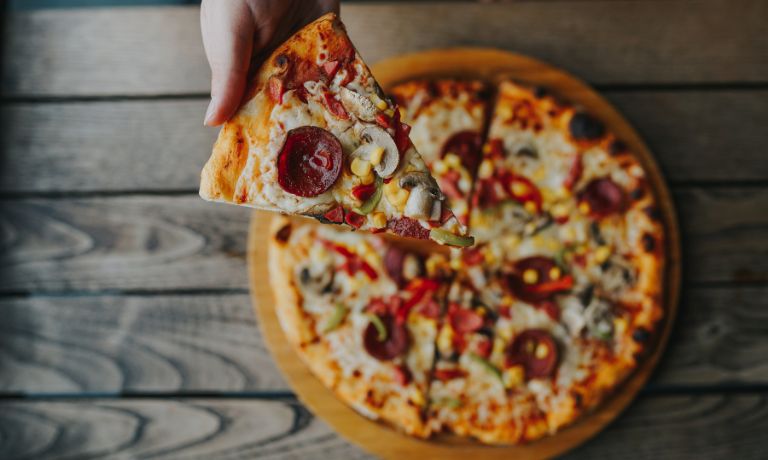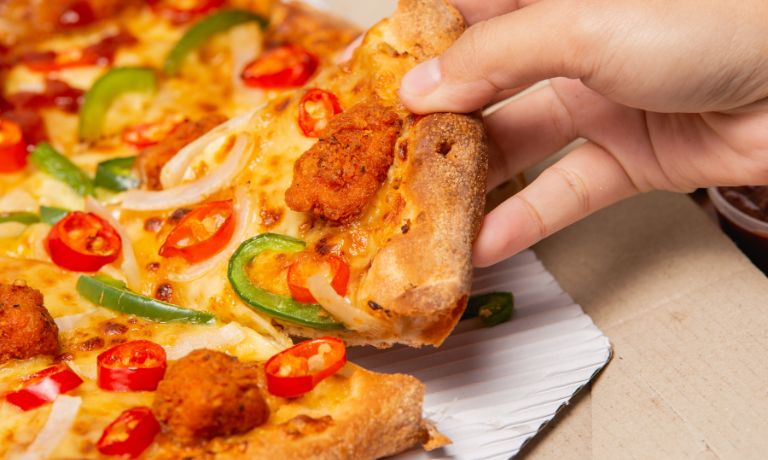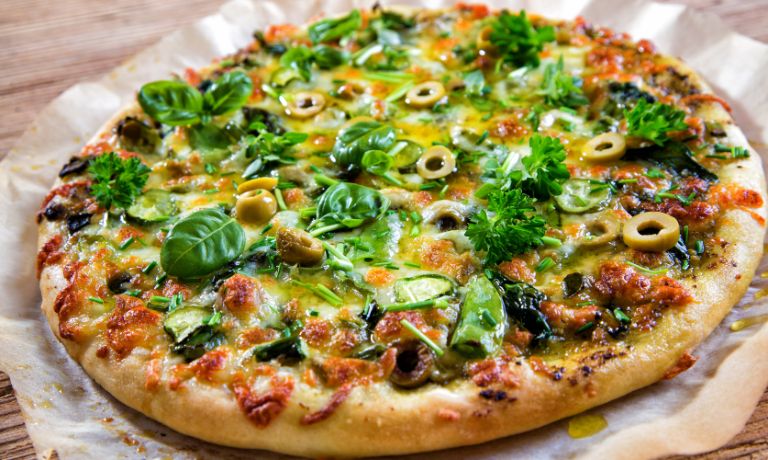If you’re a health-conscious foodie, chances are you’ve asked yourself “How Many Calories Are In A Slice Of Pizza?” Knowing how many calories are in the food we consume can help us make smarter dietary decisions and gain better nutrition.
In this blog post, we explore the nutritional information behind one of America’s most loved comfort foods – pizza! We will discuss the various factors that impact calorie count, so you know exactly what to expect when ordering your next pizza pie.
Understanding The Basics Of Calories And Nutrition
The term ‘calorie’ is a unit of measurement used to describe how much energy food provides.
Calories come primarily from fat, carbohydrates and protein, but other nutrients like vitamins, minerals and fiber also contribute to the nutritional value of food.
Different types of pizza may contain different numbers of calories based on the type and amount of ingredients used, so it can help to consider the typical composition of a slice of pizza.

A Slice of Pizza
How Many Calories Are In A Slice Of Pizza?
The number of calories in a single slice of pizza can range from approximately 200 to 500 calories, depending on the type and size of the pizza. A typical slice of cheese pizza is estimated to contain between 230 to 310 calories, while a slice of pepperoni pizza contains around 300 to 390 calories.
Overall, the number of calories in a single slice of pizza can vary greatly depending on the size, toppings and type of crust used. Knowing how many calories are in a slice of pizza can help you make informed decisions about how much indulgence fits into your diet.
Calorie Counts for Popular Pizza Toppings
To help you make more informed decisions, here is a breakdown of the approximate number of calories in some popular pizza toppings:
– Pepperoni: Pepperoni is one of the most popular pizza toppings, adding around 50 calories per slice.
– Cheese: Providing a rich and flavorful base, cheese adds about 80 to 100 calories per slice.
– Olives: Olives are a great way to get some healthy fats and add flavor without too many extra calories, only 10-15 calories per slice.
– Mushrooms: Adding a unique flavor and texture, mushrooms are relatively low in calories, only 5-10 calories per slice.
– Pineapple: Sweet and tangy pineapple is a great topping for pizza, with just 15 to 20 calories added per slice.
– Ground beef: A flavorful topping, ground beef adds about 30 to 40 calories per slice.
– Bacon: A classic favorite, bacon adds around 25 calories per slice.
– Ham: With a savory and slightly sweet flavor, ham adds about 15 to 20 calories per slice.
– Sausages: Adding a kick of flavor, sausages contribute about 35 to 45 calories per slice.
[display-posts id=”180″ image_size=”thumbnail” posts_per_page=”1″]
Calorie Counts for Different Pizza Brands
It’s also important to consider the calorie counts for different pizza brands. For example, a medium-sized slice of cheese crust from Domino’s Pizza contains 270 calories. A large thin-crust pepperoni slice at Pizza Hut contains 290 calories while an extra-large Crust Italian sausage slice at Papa Johns’s has 420 calories.
We will figure out the calories in each slice of some famous pizza brands:
- Calories in a slice of Pizza Hut:
– Personal Pan Pepperoni Pizza Slice: 310 calories
– Medium Hand-tossed Cheese Pizza Slice: 270 calories
– Large Thin ‘N Crispy Cheese Pizza Slice: 200 calories
- Calories in a slice of Domino Pizza:
– Hand Tossed Cheese Pizza Slice: 250 calories
– Specialty Chicken & Bacon Carbonara: 310 calories
– Brooklyn Style Pepperoni Slice: 290 calories
- Calories in a slice of Little Caesars:
– Cheese Pizza Slice: 220 calories
– Pepperoni Pizza Slice: 260 calories
- Calories in a slice of California Pizza:
– Cheese Pizza Slice: 220 calories
– Margherita Pizza Slice: 290 calories
- Calories in a slice of Papa Murphy’s Pizza:
– Large Classic Pepperoni Slice: 330 calories
– Medium Original Crust Cheese Slice: 220 calories
- Calories in a slice of Costco Pizza:
– Cheese Pizza Slice: 400 calories
– Pepperoni Pizza Slice: 420 calories

Pizza
Nutritional Benefits of Pizza
Pizza can be part of a balanced diet and is an excellent source of complex carbohydrates, vitamins, minerals and dietary fiber. A slice of cheese pizza contains high levels of protein and calcium, as well as significant amounts of phosphorus, magnesium and copper. Additionally, depending on the toppings used, pizza can provide essential nutrients such as Vitamin B6, Vitamin E and iron.
All in all, pizza can be a good source of nutrients and calories if consumed in moderation. Knowing the calorie counts of different types of pizza can help you make healthier choices and manage your overall caloric intake.
[display-posts id=”47″ image_size=”thumbnail” posts_per_page=”1″]
How Many Carbs In A Slice Of Pizza?
Carbohydrate content can vary depending on the type of pizza crust and toppings used. A regular slice of cheese pizza contains approximately 25-30 grams of carbs, while a thin-crust slice has about 20-25 grams of carbs.
Meanwhile, specialty pizzas with high-carb toppings such as pineapple or sausage will have higher carbohydrate content. It’s important to note that crustless pizzas are a good low-carb option and contain no more than 10 grams of carbs per slice.
Factors That Affect the Number of Calories in a Slice of Pizza
The number of calories in a slice of pizza can vary depending on the type, size and ingredients used. Some common factors that affect calorie count include:
– Crust: Thick crusts typically contain more calories than thin or regular crusts.
– Toppings: Certain toppings like pepperoni, sausage and cheese will add more calories to your pizza.
– Size: Larger slices will contain more calories than smaller ones.
[display-posts id=”560″ image_size=”thumbnail” posts_per_page=”1″]
– Type of cheese: Lower-fat cheeses like part-skim mozzarella will contain fewer calories than full-fat cheeses such as cheddar or Parmesan.
– Additional sauces: Creamy sauces and toppings can add extra calories to your slice.

Pizza with Vegetable Topping
The Health Effects Of Pizza Consumption
When consumed in moderation, pizza can be part of a balanced diet and provide essential nutrients. However, its high-calorie content makes it an unhealthy choice when eaten in large amounts or frequently.
Eating too much pizza can lead to weight gain, increased cholesterol levels and an increased risk of heart disease. You should limit pizza consumption to one or two slices per day.
Additionally, opting for healthier toppings such as vegetables, lean meats and lower-fat cheeses can help reduce the calorie content of your slice.
Finally, if possible, choose whole-wheat crust instead of regular white crust to get more dietary fiber.
[display-posts id=”563″ image_size=”thumbnail” posts_per_page=”1″]
How to Reduce the Number of Calories in a Slice of Pizza
If you’re looking to reduce the calorie content of your pizza, there are several things you can do. Here are some tips for reducing the number of calories in a slice of pizza:
– Choose thinner crusts or whole wheat crusts whenever possible.
– Cut back on toppings and opt for healthier options such as vegetables, lean meats and lower-fat cheeses.
– Avoid adding extra sauces or cream cheese to your pizza.
– If possible, choose smaller slices for a lower calorie count.

Vegan Pizza
FAQs
How many calories in a typical slice of pizza?
A typical slice of pizza 14-inch regular crust and basic ingredients can contain approximately 285 calories.
How many calories are in 2 large slices of pizza?
2 large slices of pizza can contain approximately 570 calories and up, depending on the ingredients and toppings.
How many calories in a slice of pepperoni pizza?
A slice of pepperoni pizza on a regular crust can contain about 340 calories. The calorie content will depend on the size and type of toppings used.
Is it OK to eat a slice of pizza on a diet?
Yes, eating a slice of pizza can still fit into your diet.
To reduce the calorie content, opt for thinner crusts or whole wheat crusts and choose healthier toppings such as vegetables, lean meats and lower-fat cheeses. Additionally, it’s important to limit portion size to one or two slices per day.
[display-posts id=”188″ image_size=”thumbnail” posts_per_page=”1″]
Is 180 calories a lot for a snack?
It depends on the type of snack and your overall calorie goals. 180 calories can be a reasonable amount for a snack, however it’s important to consider your individual calorie needs when planning meals and snacks.
For example, if you’re looking for a snack that is low in calories, whole grain crackers or a piece of fruit may be better options than a slice of pizza.
Which pizza has the most calories?
Pizzas with thicker crusts, extra cheese and heavy toppings can have the highest calorie counts.
For example, a 14-inch deep dish pizza with extra cheese and pepperoni can contain up to 700 calories per slice.
What pizza has the least calories?
Thin-crust pizzas with vegetables and light toppings tend to have the lowest calorie counts.
For example, a 14-inch thin-crust pizza with light cheese and vegetables can contain around 175 calories per slice.
How many calories should I eat to lose weight?
Your calorie needs depend on your individual goals and current weight. In general, to lose weight, it’s recommended to reduce calories by 500-1000 per day.
It’s also important to combine calorie reduction with regular physical activity and healthy eating habits for long-term success. Speak to your healthcare provider or a nutritionist for personalized advice on calorie goals and how to achieve them safely.
Is pizza healthy or burger?
A burger is higher in fat content than pizza slices, so it’s important to consider your individual goals and dietary preferences when choosing between a burger or pizza.
[display-posts id=”680″ image_size=”thumbnail” posts_per_page=”1″]
What is the unhealthiest part of pizza?
The crust is typically the unhealthiest part of the pizza, as it is often made with white flour and can contain large amounts of sodium and saturated fat. To reduce the calorie and sodium content, opt for thinner crusts or whole wheat crusts.
What is healthier pizza or pasta?
Both pizza and pasta contain carbohydrates, however, pizza typically contains higher amounts of fat.
Therefore, it’s important to consider your individual caloric needs and dietary preferences when making a choice between pizza and pasta.
Conclusion: How many calories are in a slice of pizza?
A slice of pizza can contain anywhere between 200-500 calories, depending on the type and size. Factors such as crust thickness, toppings used, type of cheese, additional sauces and size will all affect the calorie count.
Making healthy choices when it comes to pizza is important in order to avoid excessive calorie intake and potential health risks.
Healthy eating tips such as opting for thinner crusts, choosing leaner toppings and limiting portion size can help reduce calorie content. By following these tips, you’ll be able to enjoy the taste of pizza while still maintaining a healthy diet.


